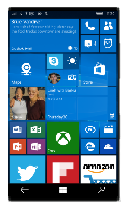Smartphone
Smartphones come in a wide range of sizes from low cost phones, small tablets (phablets) and industrial handheld devices. A typical smartphone combines cellular connectivity, a touch screen, rechargeable power source, and other components into a single chassis. Windows 10 Mobile can support a wide range of small form factors devices. Listed below are a few recommended hardware configurations.
|
|
|
||
Type |
Value Phone |
Premium Phone |
Value Phablet |
| Key Features | |||
| Operating System | Windows 10 Mobile | ||
Recommended components |
|||
CPU |
Supported entry SoC |
Supported premium SoC |
Mid tier supported SoC |
RAM/Storage |
1 GB / 8 GB with SD slot |
2-4 GB / 32-64 GB with SD slot |
2 GB / 16 GB with SD slot |
Display |
3.5”–5”+ / WVGA -FWVGA-qHD* |
4.5–5.5”+ / FHD-WQHD |
5.5”–7” / 720p+ |
Dimensions |
< 10.05 mm & < 135g |
< 7.5 mm & < 160g |
< 10 mm & < 175g |
Battery |
1400 mAh+ (1 day active use) |
2500+ mAh (1 day active use) |
3000 mAh+ (1 day active use) |
Connectivity |
3G (LTE/Cat 3) / 802.11b/g/n, microUSB, 3.5 mm jack, BT LE |
LTE/Cat 4+ / 802.11b/g/n/ac 2x2, USB, 3.5 mm jack, BT LE, NFC |
LTE/Cat 3 / 802.11b/g/n/ac 2x2, USB 3.0 type-c, 3.5 mm jack, BT LE, NFC |
Camera+ |
5 MP, .3 MP FFC |
20 MP with OIS/Flash; 5 MP FFC |
5 MP, .3 MP FFC |
* qHD requires > 512 MB memory.
For more guidance in selecting hardware components, see Hardware component guidelines.
Research the Windows Mobile options and partner with a registered Windows phone manufacturer to build a device utilizing your brand. For more information, see Windows 10 Hardware Developer Programs.

